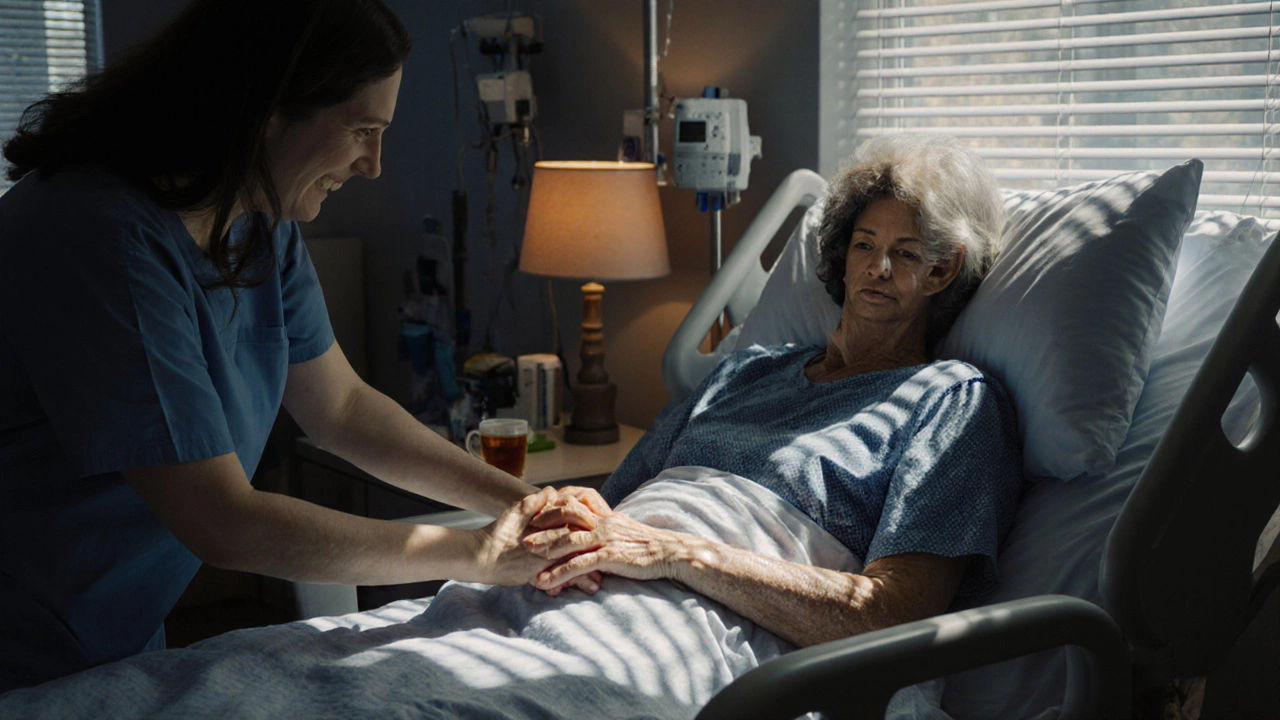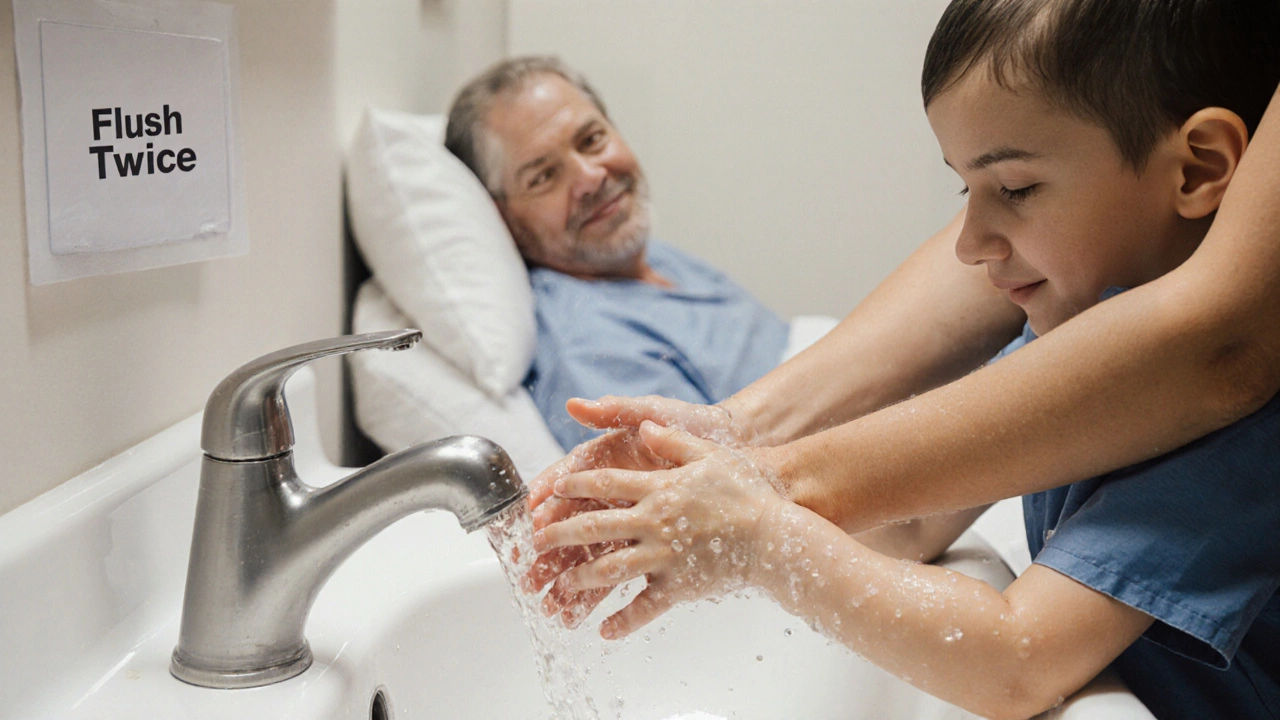
Chemo Safety Contact Calculator
Enter the patient's current medical information and your health status to determine if physical contact is safe. This tool is based on guidelines from oncology professionals.
Important Notes: This calculator provides general guidance only. Always consult the patient's oncology team for personalized medical advice.
Safety Assessment
Key Guidelines: Always ask before touching, wash hands thoroughly, avoid face contact, and consult the patient's medical team.
Many people want to hug a loved one going through chemotherapy-but they’re told not to. It’s not that you’re being cold or distant. It’s about safety. Chemo patients are more vulnerable than you might think, and even a simple touch can carry risks. You don’t need to stay away entirely. You just need to understand why and how to be there the right way.
Chemotherapy Weakens the Immune System
Chemotherapy doesn’t just attack cancer cells. It also damages healthy cells-especially the ones in your bone marrow that make white blood cells. These white blood cells are your body’s frontline defense against infections. When chemo lowers their numbers, a person becomes severely immunocompromised. Their immune system can’t fight off germs the way it used to.
A common cold virus that would normally make you sneeze for a few days could land a chemo patient in the hospital. A tiny cut on your hand, a lingering cough, or even a kiss on the cheek could pass along bacteria or viruses they have no defense against. Infections during chemo are not just uncomfortable-they’re life-threatening. About 20% of hospitalized cancer patients on chemo develop serious infections, and nearly 1 in 10 of those cases result in death, according to data from the American Cancer Society.
It’s Not Just About Germs-It’s About Chemical Exposure
Chemotherapy drugs are powerful. They’re designed to kill fast-growing cells. That’s why they work on cancer. But they also stay in the body for days after treatment. The body gets rid of them through sweat, urine, vomit, and even saliva. That means a chemo patient’s bodily fluids can still contain traces of the drugs for up to 72 hours after their last dose.
While casual skin contact won’t harm you, prolonged or repeated exposure-like hugging for long periods, kissing on the mouth, or sharing a bed-can lead to absorption through the skin or accidental ingestion. Pregnant women, young children, and people with their own immune issues are especially at risk. Hospitals and oncology clinics often give patients special instructions: use separate bathrooms, flush twice after using the toilet, and wash hands thoroughly after going to the bathroom. These aren’t just suggestions. They’re safety protocols.
Touch Can Still Be Safe-Here’s How
You don’t have to give up physical connection. You just need to adjust how you do it.
- Wash your hands before and after visiting. Use soap and water for at least 20 seconds. Hand sanitizer works too, but soap is better if your hands are visibly dirty.
- Hold hands instead of hugging. A gentle squeeze is comforting and carries zero risk if your hands are clean.
- Avoid face contact. No kissing on the lips, no rubbing noses, no blowing kisses. Even a sneeze near their face can be dangerous.
- Stay home if you’re sick. Even a mild sore throat or runny nose should keep you away for at least a week. Better to wait than risk their life.
- Ask before you touch. Some patients are more sensitive than others. Some have open wounds, IV lines, or port sites. Always check: “Is it okay if I hold your hand?”
Many patients say the most meaningful moments aren’t big gestures-they’re quiet ones. Sitting beside them while they watch TV. Reading to them. Making them a cup of tea. These actions say, “I’m here,” without putting them at risk.

What About Hugging? Can You Ever Do It?
Yes-but only under the right conditions.
If the patient is in the maintenance phase of treatment and their white blood cell count is stable (usually above 1,000 cells/µL), and if you’ve been healthy for at least 10 days, a brief, gentle hug may be safe. But it’s not automatic. Always ask their oncology team first. Some patients will say yes. Others will say no-and that’s okay. Their body is still fighting.
There’s also the emotional side. Many patients feel isolated. They’re told not to go to crowded places, not to eat at restaurants, not to be around kids. When someone says, “I can’t hug you,” it can feel like rejection-even if it’s for their protection. That’s why communication matters. Say: “I want to hug you, but I want you to be safe. Can we find another way?”
What About Kids and Pets?
Kids are great at spreading germs. They touch everything, then their faces. If a child is sick, even with a minor cold, they should not visit a chemo patient. If they’re healthy, supervise them closely. No kissing, no climbing on the patient, no sharing toys or food. Wash their hands before and after.
Pets can be safe too-but with rules. Wash your pet’s paws before they jump on the bed. Don’t let them lick the patient’s face. Avoid letting pets sleep in the same bed if the patient has an open wound or a central line. A calm, clean pet can be a huge comfort. But hygiene matters more than affection.
Supporting Someone on Chemo Isn’t About Touch-It’s About Presence
The most powerful thing you can do for someone on chemotherapy isn’t a hug. It’s showing up. Bringing a meal they actually like. Driving them to appointments. Sitting quietly while they nap. Sending a text that says, “I’m thinking of you,” without expecting a reply.
Many patients say the loneliness hits harder than the nausea. They feel like a burden. They worry people are avoiding them. When you show up-even from a distance-you remind them they’re not alone.
Some families set up a “safe visit” schedule: one person per day, no visitors under 12, everyone washes hands, no flowers (they carry mold), no uncooked food. These aren’t restrictions. They’re acts of love.

What If You’re the One on Chemo?
If you’re the patient, it’s okay to say no. It’s okay to ask for space. It’s okay to say, “I need hugs, but only if you’ve been healthy for two weeks.” You’re not being difficult. You’re protecting your life.
Let people know what helps. “I’d love it if you brought me soup.” “Can you read to me for 10 minutes?” “Can you just sit here while I rest?” Most people want to help-they just don’t know how. Give them clear, simple instructions. That’s kindness too.
Myth vs. Reality
- Myth: Chemo is contagious. Reality: You can’t catch cancer or chemo from someone else. But you can pass germs to them-and that’s dangerous.
- Myth: Only family should visit. Reality: Friends, neighbors, coworkers-all can support safely if they follow basic rules.
- Myth: Touching them will hurt them physically. Reality: It’s not about pain. It’s about infection risk. Gentle touch is often soothing.
- Myth: Once treatment ends, everything’s fine. Reality: Immune recovery can take months. Some patients stay at risk for over a year after chemo ends.
Understanding the difference between myth and fact helps you act with care-not fear.
Final Thought: Love Has Many Forms
You don’t need to hug someone to show you care. A handwritten note. A playlist of their favorite songs. A quiet cup of tea left outside their door. These things carry weight. They say, “I see you. I’m here. I’m not going anywhere.”
Chemotherapy is hard. But it doesn’t have to be lonely. With a little awareness, you can be the steady presence they need-without putting their life at risk.
Can you hug someone after chemotherapy?
Yes-but only when their immune system has recovered enough. This usually means waiting until their white blood cell count returns to normal, which can take weeks or months after the last treatment. Always check with their oncologist first. When in doubt, opt for a hand-hold or a wave instead.
Is it safe to kiss a chemo patient?
Kissing on the cheek is usually fine if you’re healthy. But kissing on the lips is not recommended, especially during active treatment. Chemo drugs can be present in saliva for up to 72 hours after a dose. Even small amounts can be harmful to people with weakened immune systems or pregnant partners.
Can you share food with a chemo patient?
It’s best to avoid sharing food, drinks, or utensils. Chemo patients are at high risk for foodborne illnesses. Even a small amount of bacteria from a shared spoon or a bite from your plate can cause serious infection. Instead, bring them their own meal in a clean container.
How long after chemo is it safe to be around others?
The risk is highest during active treatment and for 48-72 hours after each dose. After treatment ends, immune recovery varies. Most patients are still at increased risk for 3-6 months. Some take up to a year to fully rebuild their white blood cell count. Always follow your doctor’s advice on when it’s safe to resume normal contact.
Can children visit chemo patients?
Yes-if they’re healthy, haven’t been sick in the last two weeks, and are supervised. Children carry more germs than adults. Make sure they wash hands before and after visiting, don’t kiss the patient, and don’t share toys or snacks. If the child has a cold, fever, or rash, they should stay home.
Why do hospitals tell visitors to wash hands so often?
Because germs on hands are the most common way infections spread. A single touch on a doorknob, bed rail, or IV pole can transfer harmful bacteria. Washing hands removes those germs before they reach the patient. It’s the single most effective way to protect someone with a weak immune system.

Write a comment